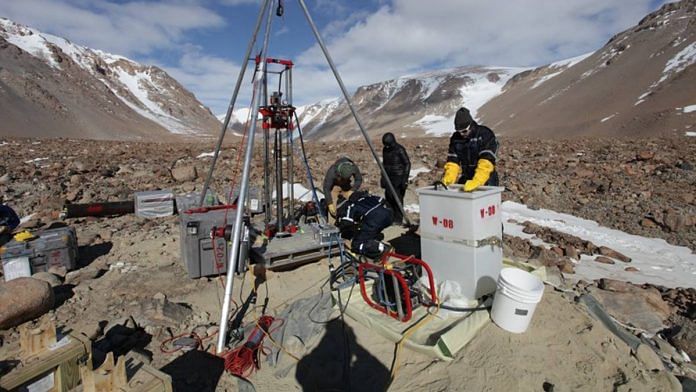Bengaluru: Researchers in Antarctica have extracted a 9.44-metre-long ice core, which contains ice that is estimated to be 5 million years old. It is believed to be the oldest ice sample ever retrieved.
Examination and study of the ice sample presents enormous possibilities for understanding ancient climate and today’s changing climate. The methods used by the researchers to measure the age of ice could aid in studying other older ice samples.
The extraction was made by a team of researchers from multiple US institutes and organisations: University of North Dakota, the Berkeley Geochronology Center, Vanderbilt University, and University of Vermont.
The findings were published last month in the journal The Cryosphere.
Unlike traditional ice core extraction, which requires drilling deep under layers of sedimentary ice, this sample was found buried under a rock in Ong Valley in the Transantarctic Mountains.
Millions of years ago, this ice had flowed into the valley as part of a glacier and was exposed to the surface in the process, after which it is believed to have become covered with debris and rock.
The age of the ice in this region was previously estimated to be over a million years old, as measured by the effects of cosmic rays from space on quartz crystals present in the ice. Previously, the oldest extracted ice dated back 8,00,000 years.
The extracted sample is made up of two different ice masses stacked together. The upper, newer ice mass is thought to be about 2,20,000 years old, and said to have come from within the glacier. But the mass below it is older, having been exposed to the surface after initial burial and covered with rock, estimated to be 4.3 million-5.1 million years old.
Also read: Govts must act within decade to mitigate extreme climate change impact, says latest IPCC report
Ice cores and flowing ice
Ice cores are obtained by drilling into metres-thick ice and obtaining long tubes of icy material, or “cores”. The cores contain layers of ice by seasonal snowfall and deposition, stacked by year, with the uppermost part of the ice being the most recent.
These cores can be sliced into different time periods and material, which provides information about the climate when the ice was freshly fallen snow. Fresh snow can trap air bubbles and also have atmospheric particles settle on it, which can indicate the nature of ancient climate.
Scientists have been attempting to build a meticulous climate record of the past by obtaining continuous ice core samples, hoping to extend up to 1.5 million years ago. However, drilling deeper is more expensive and can take long periods of time, even decades.
A 2016 study showed that buried ice in the Ong Valley was at least 1.1 million years old, possibly older than 2.6 million years. The estimates were done through a method called cosmogenic nuclide dating.
The researchers behind the new findings used these findings to excavate the ice that was identified in the 2016 study.
Cosmogenic nuclide dating
Cosmogenic nuclides are rare isotopes of elements that are created when cosmic rays — high-energy protons and nuclei whizzing through space — interact with the nucleus of an atom on Earth, releasing protons and neutrons from the atom. These isotopes or nuclides form inside rocks, meteorites, and also in planetary atmospheres.
The terrestrial cosmogenic nuclides measured in the previous study were those of Beryllium (Be), Aluminium (Al), and Neon (Ne), within the debris that was mixed up with the ice.
The team of researchers in the latest study collected their ice core in 2017-2018. They also developed a model that predicted how the rare isotopes of Be, Ne, and Al built up in the ice, and used the predictions to measure the isotope profiles of the nearly 10-metre-long core.
After detecting ice dating to hundreds of thousands of years ago, they discovered ice dating to 3 million years ago. But as they progressed below that depth of ice, the isotope concentrations were even higher, leading them to conclude that the lower sections of the ice mass could be as old as 5.1 million years.
However, the researchers did not measure carbon isotope levels.
The findings will provide clues into past climate going back millions of years, and also make more accessible ice core samples older than one million years.
(Edited by Nida Fatima Siddiqui)
Also read: Arctic heating up 4x as fast as rest of world: Finnish study claims ‘pace underestimated’ so far



